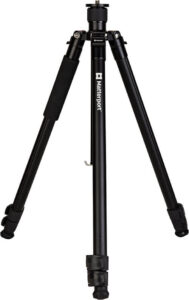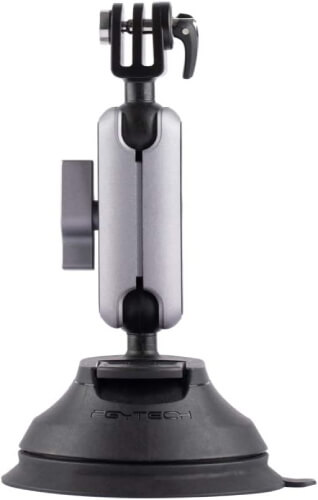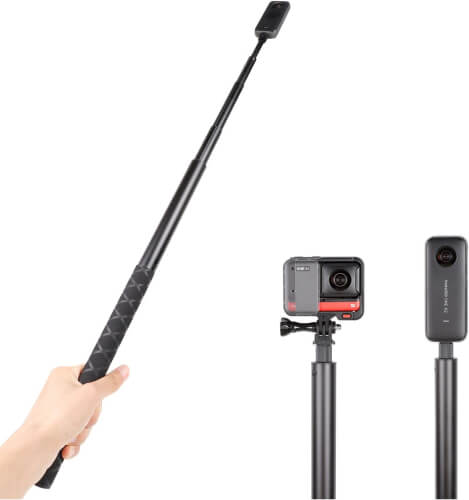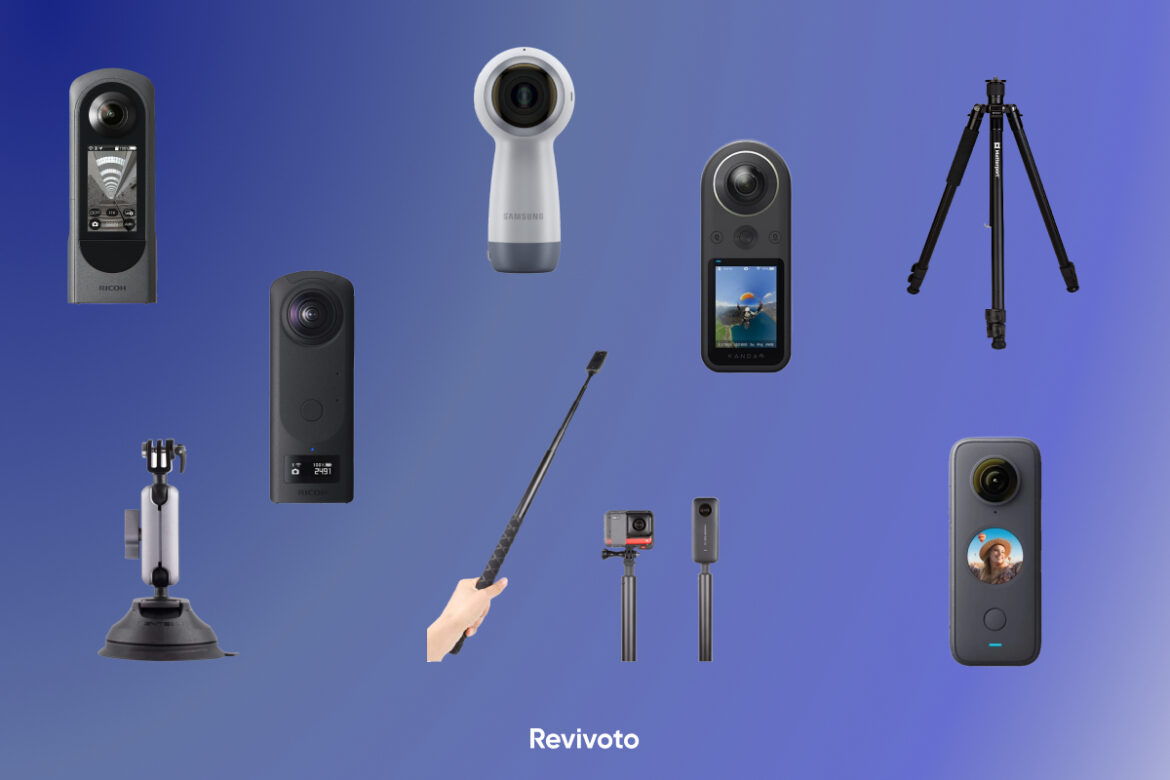Virtual tours have transformed how we explore and experience spaces by combining reality and digital innovation, allowing us to teleport to distant places or examine the intricate details of incredible structures without leaving our homes. But have you ever wondered what’s going on behind the scenes of these mind-blowing virtual reality tours? The answer is a virtual tour camera that lets you record every angle, detail, and moment, creating virtual landscapes with incredible clarity and realism.
If you want to make breathtaking 360-degree virtual tours, this post will explore virtual tour camera equipment used to create them, from cameras to tripods and lighting equipment.
Table of Contents
Top Factors for Selecting a Virtual Tour Camera
There are several vital factors you have to consider when choosing a virtual tour camera. These factors can significantly impact the quality of your virtual tour. Let’s look at some important considerations to keep in mind:
Image resolution and sensor size
Your virtual tour camera must have high megapixel counts and large sensor sizes to ensure excellent image quality. These cameras can capture more detail and produce sharper, more immersive images. Generally, a camera with a resolution of at least 5.7K is recommended. This will ensure that the virtual tour is sharp and detailed, even when viewed on a large screen.
Lens options and interchangeability
A camera with interchangeable lenses provides versatility and allows you to capture a variety of perspectives. Wide-angle lenses are useful for capturing expansive spaces, while macro lenses can help capture complex details.
Low-light performance
Virtual tours often involve shooting in different lighting conditions, from dark interiors to bright outdoor scenes. So, you should choose a camera that performs well in low-light environments, with good ISO capabilities, and low noise levels.
Durability and portability
Virtual tours can take you to various locations, so it’s essential to have a stable and portable camera. Consider buying a camera built for challenging conditions and light enough to carry easily.
Autofocus speed
For creating virtual tours, you must capture a series of images quickly, especially when shooting in dynamic environments or with moving subjects. Therefore, you need a fast, accurate autofocus camera to capture sharp, well-focused photos without missing important moments.
There are two main types of autofocus systems: contrast-detection and phase-detection. Contrast-detection autofocus is slower than phase-detection autofocus, but it is more accurate. Phase-detection autofocus is faster than contrast-detection autofocus, but it is less accurate. A camera with fast autofocus will ensure that the virtual tour is smooth and seamless, even when the user is panning or zoo.
Processing speed
The camera’s processing speed affects how quickly it can handle image data and perform tasks like image playback and menu navigation. A faster processing speed can improve your overall shooting experience and workflow efficiency. For example, a camera with a processing speed of at least 5 frames per second (fps) would be suitable.
Budget considerations
There are different kinds of cameras available at various price points, so before making a decision, you must evaluate your budget and needs.
Best Camera Types for Virtual Tours
There are several types of cameras suitable for capturing virtual tours, including:
DSLR cameras
Digital Single-Lens Reflex (DSLR) cameras are popular among professional photographers due to their versatility and image quality. These cameras include interchangeable lenses, allowing you to adapt to various shooting situations. DSLRs provide excellent image resolution, dynamic range, and low-light performance, making them perfect for creating comprehensive and engaging virtual tours. However, they are large and heavy, which affects their portability.
| Pros | Cons |
| Excellent image quality and low-light performance | Bulky and heavy, less portable |
| Interchangeable lenses | Expensive |
| Advanced manual controls |
Mirrorless cameras
Mirrorless cameras offer similar image quality to DSLRs in a more compact form factor. They don’t have a traditional mirror or optical viewfinder, resulting in a smaller and lighter camera body. They are perfect for virtual tours because of their high-resolution sensors, quick-focusing systems, and advanced video capabilities. These cameras include interchangeable lenses for further flexibility.
| Pros | Cons |
| Compact and lightweight, highly portable | A smaller selection of lenses |
| Excellent image quality and low-light performance | Electronic viewfinder |
| Fast autofocus and continuous shooting capabilities | Limited battery life |
| Advanced video capabilities | |
| Professional-grade features and durability |
360-degree cameras
These advanced cameras capture a full spherical view of the surroundings, allowing users to navigate the virtual space and explore every angle. 360-degree cameras often have multiple lenses to capture a wide field of view and create cohesive panoramic images. They are designed specifically for immersive experiences and are another suitable option for creating virtual tours.
| Pros | Cons |
| Full spherical view capacity | Limited manual controls and customization options |
| Quick and easy to use | Limited depth of field control |
| Minimal post-processing required | |
| Compact and portable design | |
| Ideal for creating interactive and realistic virtual tours | |
| Wide range of interchangeable lenses |

Best 360-Degree Cameras
Among the virtual tour cameras, 360-degree cameras are so popular because they are flexible, easy to use, and cost-effective also, enable users to create a comprehensive view of aspects with high-quality resolution. There are various reliable 360-degree cameras on the market that are suited for taking virtual tours, which we will discuss in the next part. You can also read “Which 360 Camera Is Best for Shooting Real Estate Virtual Tours and Staging?” for more details.
| 360 camera | Pros | Cons |
| Ricoh Theta Z1 | High-resolution 360 images Simple to use Auto HDR mode Excellent one-inch sensors Lightroom plugin | Costly Less resolution than rivals No MicroSD slot |
| Ricoh Theta X | High-resolution 360 images User-friendly Auto HDR mode No software is required 5.7K video Ample memory | Smaller sensor size |
| Samsung Gear 360 | High-resolution 360 images 180-degree lenses Works with Samsung and IOS | Doesn’t work with Android phones except for Samsung Poor desktop software |
| Trisio Lite 2 | High-resolution 360 images User friendly Auto HDR mode Affordable | No video mode Limit options |
| QooCam 8K | High-quality DNG 8 images Bigger sensors HDR mode | Needs desktop software |
| Xiaomi Mijia Mi Sphere | Affordable Simple to use Bracketing mode High-resolution 360 images | A little blurriness Combining photos requires external software Less dynamic |
| Insta360 One X2 | HDR mode Super 5.7K 360° video encoded using H.265 Waterproof Immersive 360° audio with 4 internal microphones and a sophisticated wind-reduction algorithm Steady Cam Mode Gimbal-like FlowState Stabilization Invisible Selfie Stick Shooting time shift videos Pureshot photo mode Pocket size Full touch screen | Short battery life Vulnerable |
| Ricoh Theta SC2 | Lightweight design Bluetooth Flexible tripod 4K video recording Night view Underwater mode Good image quality | Expensive Stitching issues In-built battery |
| Matterport MC250 Pro2 | High-resolution 3D photos 4K print-quality photography Photo resolution at 134 megapixels Pair with iOS or Android device | The maximum scan range of 4.5 meters Short battery life |
Virtual Tour Camera Equipment
Tripods, mounts, and monopods play a crucial role in virtual tour photography by providing stability and allowing for precise positioning of the camera. They ensure that your shots are steady, level, and consistent, resulting in professional-looking virtual tours.
Tripod
Key points for choosing tripods:
Strong construction and adjustable height
Select a tripod with height-adjustable legs and a center column to support the weight of camera equipment and provide height flexibility.
Ball head or pan-tilt head options
A ball head provides smooth and easy adjustment in any direction, while a pan-tilt head offers separate controls for precise movement along different axes.
Compatibility with camera type and weight
The tripod should be compatible with your camera type and support its weight. Consider the maximum load capacity of the tripod to ensure stability.

Mount
Important factors for choosing mounts and brackets:
Pano heads
Panoramic heads enable exact rotation around the camera’s nodal point, resulting in perfect picture stitching and immersive 360-degree panoramas.
Motorized mounts
Motorized mounts allow for automatic motions such as smooth rotation or panning, which is useful for shooting dynamic virtual tours. These mounts can be controlled remotely or programmed to move in specific patterns.
Leveling bases
Leveling bases help ensure that your camera is perfectly level, particularly when shooting panoramic images or capturing multiple shots for stitching. They allow for quick and precise leveling adjustments, contributing to a seamless virtual tour experience.

Monopod
Monopods have a single leg that can provide support and assist in capturing smooth and steady shots. Important factors for choosing monopods include:
Construction and stability
The monopod should be made from solid materials that offer durability and stability, such as aluminum or carbon fiber. Look for a model that can support the weight of your camera and lens combination without compromising stability.
Height adjustment and locking mechanism
Look for a monopod with adjustable height options and a reliable locking mechanism to ensure stability during shooting.
Grip and comfort
Choose a monopod with a comfortable and ergonomic grip. Rubberized or foam grips offer better handling and minimize hand fatigue during extended shooting sessions. Some monopods also offer adjustable wrist belts for added security and convenience.
Quick-release plate
A quick-release plate allows for easy and quick attachment and detachment of your camera to the monopod.
Compatibility with accessories
Consider the compatibility of the monopod with additional accessories such as smartphone holders, mounting brackets, or remote triggers to increase the range of shots you can capture during virtual tours.
Portability
Lightweight and compact monopods are ideal for on-the-go virtual tour photography. Choose a foldable model for easy transportation and storage.

Virtual Tour Lighting Equipment
Proper lighting can make a significant impact on the overall aesthetics and mood of your virtual tours. Here are some key aspects of choosing lighting equipment for virtual tours:
External flash units
External flash units, also known as spotlights, provide additional light when shooting in low-light conditions or when you need to balance the lighting in a scene. it is recommended to choose flash units with adjustable power output and diffusing options to control the intensity and spread of light. Some models also offer features like TTL (Through The Lens) metering, which measures the light output automatically for accurate exposures.
Continuous LED lights
Continuous LED lights are versatile and provide a constant light source for virtual tour photography. They are available in various sizes and configurations, from small on-camera lights to larger panel lights. Look for LED lights with adjustable color temperature and intensity controls to match the existing ambient light and create the desired mood. You can use Softboxes, diffusers, or reflectors to modify the light and create a more even and pleasing lighting setup.
Light stands and modifiers
Light stands are essential for positioning and supporting lighting equipment and should be stable and adjustable in height. Modifiers like reflectors, umbrellas, or barn doors can be attached to the equipment to shape and control the light. Reflectors bounce light onto the subject, umbrellas soften and diffuse the light, and barn doors help direct and restrict the light’s spread.
Virtual Tour Camera Accessories
Some essential accessories for virtual tour photography include:
Remote shutter release or intervalometer
A remote shutter release allows you to activate the camera without touching it, minimizing the risk of camera shake. An intervalometer enables you to automate timed intervals between shots, which is useful for creating time-lapse sequences or capturing multiple images for stitching panoramas.
Memory cards and storage solutions
As virtual tour photography often involves capturing numerous high-resolution images, you should invest in high-capacity memory cards with fast read/write speeds to accommodate the large file sizes and ensure smooth shooting. Consider external hard drives or SSDs for picture backup and storage during on-location shooting.
Batteries and charging options
It is essential to buy extra batteries to keep shooting without interruption and invest in portable chargers or battery grip accessories to provide extended power options.
Conclusion
High-quality virtual tour camera equipment is crucial for capturing immersive and captivating virtual tours. You can create polished and visually engaging virtual tours by choosing the right camera, tripod, lighting equipment, and accessories, and utilizing post-processing tools. Virtual tours enable you to take your audience to spaces, highlight architectural aspects, or show the beauty of distant locations, all from the comfort of their screens.


